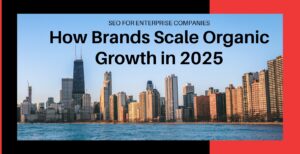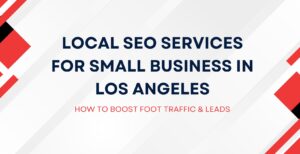Content marketing services offer businesses a structured approach to creating and distributing assets, including blog posts, whitepapers, case studies, infographics, and video scripts, that align with search intent and buyer needs. Effective systems define relevant success metrics, from lead velocity to influenced pipeline, ensuring results are measurable.
An expert content strategy connects digital visibility with business growth by building topic authority, organizing assets into clusters, and using creation services that scale without losing quality. When every piece of content is tied to intent, businesses generate qualified traffic, improve conversions, and reduce customer acquisition costs.
Table of Contents
ToggleWhat a Content Marketing Service Includes in 2025
A modern content marketing service in 2025 aligns SEO strategy, buyer personas, and performance analytics into one framework. It combines content creation, distribution, and optimization with systems that track ROI and scale across digital channels.
Core Components of a Modern Content Strategy
An effective content strategy relies on structured systems that map audience intent directly to business outcomes. Each component, from goal setting to distribution, works together to ensure content drives measurable traffic, leads, and revenue.
Core Components:
- Goal Setting: Define traffic, lead, and revenue benchmarks tied to business KPIs.
- Persona Alignment: Map assets to buyer roles, decision triggers, and funnel stages.
- Distribution Channels: Match formats to platforms (e.g., YouTube for video, blogs for SEO).
- Analytics & Feedback Loops: Use performance data to refine campaigns in real time.
- Optimization Cycles: Update assets through A/B testing and trend analysis.
These components turn content into an owned digital asset library with long-term SEO authority.
How Content Marketing Services Have Evolved From Traditional Models
Content marketing has shifted from keyword-heavy blog production to intent-driven, full-funnel systems. Traditional models measured volume; modern services emphasize topical depth, buyer relevance, and revenue impact.
Traditional vs. Modern Approaches:
| Traditional (Then) | Modern (Now) |
| Traffic-focused blog output | Full-funnel content mapped to buyer intent |
| One-size-fits-all messaging | Persona-specific assets with funnel relevance |
| Keyword stuffing for rankings | Semantic SEO and topical authority |
| Static publishing schedules | Agile systems with evergreen updates |
| Short-term vanity metrics | Business KPIs: leads, pipeline, conversions |
Strategic SEO Content Planning to Drive Business Growth
SEO content planning in 2025 is about more than rankings. By tying search behavior, funnel intent, and business KPIs together, content becomes a structured engine for generating qualified traffic, leads, and measurable revenue growth.
The following pillars show how specific planning choices align goals with outcomes, turn assets into revenue engines, and reduce acquisition costs through evergreen strategies.
Aligning Content Goals With SEO Business Objectives
SEO content planning creates business impact only when objectives translate into measurable outcomes. Each goal, whether increasing lead velocity, improving conversion rates, boosting customer acquisition, enhancing brand authority, or reducing bounce rates, requires a precise SEO tactic to achieve it:
- Increase Lead Velocity: Target BOFU queries with transactional keywords to capture conversion-ready demand.
- Improve Conversion Rates: Refine internal linking, UX, and CTA placement on high-traffic assets.
- Boost Customer Acquisition: Build topic clusters around high-value commercial-intent keywords.
- Enhance Brand Authority: Publish pillar pages supported by expert-driven blogs to signal topical depth.
- Reduce Bounce Rates: Match search intent with accurate, user-focused on-page relevance.
Turning Organic Content Into a Revenue-Generating Engine
When content is built around buyer intent, it serves as a digital asset that compounds in value over time. Pages optimized for search not only attract qualified visitors but also nurture prospects and accelerate deal flow by:
- Capturing buyer intent with bottom-funnel, search-optimized assets.
- Building brand equity through consistent, authoritative publishing.
- Generating leads passively with evergreen, discoverable content.
- Shortening sales cycles by addressing objections early in the journey.
- Increasing ROI by reducing reliance on paid acquisition.
Reducing Customer Acquisition Costs Through Compounding Content
Evergreen content reduces acquisition costs by generating traffic and leads without recurring ad spend. Research from HubSpot shows inbound leads cost 62% less than outbound, and the savings scale as assets continue to perform by:
- Driving ongoing traffic without media costs.
- Improving lead quality through intent-matched discovery.
- Extending lifespan with only minor updates.
- Covering multiple funnel stages with one piece.
- Strengthening ROI through owned channels instead of rented reach.
Leveraging Evergreen SEO Content for Long-Term Returns
Evergreen content sustains visibility because it continues to answer recurring search demand long after publication. By focusing on durable formats, businesses build assets that consistently attract traffic and support discovery across the funnel.
High-Impact Evergreen Formats:
- Pillar Pages: Anchor topic clusters and signal long-term authority.
- How-To Guides: Provide solutions for problems that don’t change over time.
- Product Tutorials: Support onboarding and recurring search demand.
- Case Studies: Act as lasting proof for bottom-funnel validation.
- FAQ Pages: Capture snippets and long-tail queries with lasting relevance.
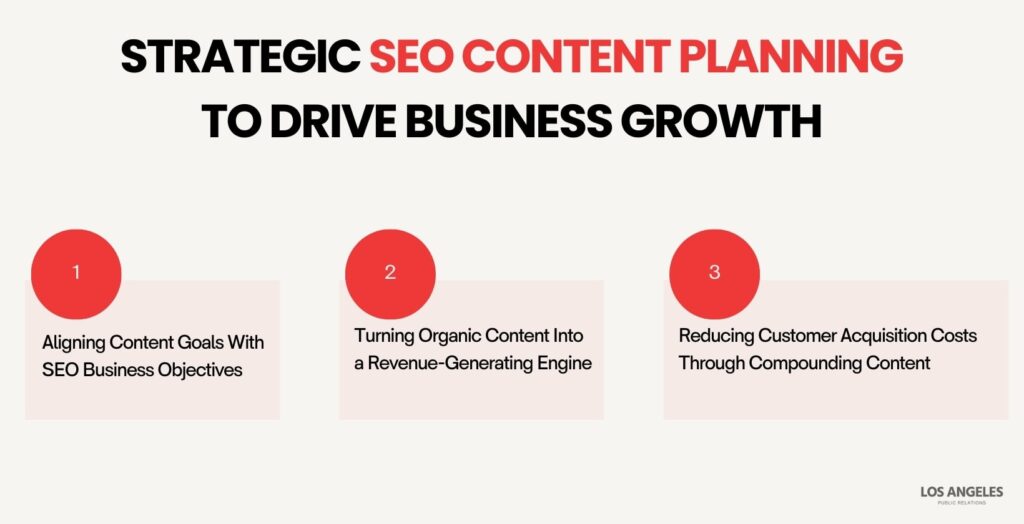
The Role of Content Marketing Across the Full Customer Journey
Content marketing is most effective when it supports the entire lifecycle, not just lead acquisition. By tailoring assets to both pre-purchase and post-purchase stages, businesses can guide prospects toward conversion and keep customers engaged long after the sale.
Mapping Buyer Intent to Funnel-Aligned Content Stages
Buyer intent changes at each stage of the journey, and content must match that intent to guide users forward. Aligning formats with goals ensures that each asset performs its intended function: educating, comparing, or converting.
- TOFU (Awareness, Informational Intent):
- Blog posts, how-to guides, checklists, social content
- Goal: Educate and attract users searching for solutions to general problems
- MOFU (Consideration, Comparative Intent)
- Webinars, comparison guides, product overviews, buying guides
- Goal: Help prospects evaluate options and understand your solution
- BOFU (Decision, Transactional Intent):
- Demos, testimonials, pricing pages, and free trial CTAs
- Goal: Convert interest into action with proof, clarity, and urgency
Delivering Content That Nurtures Loyalty and Post-Purchase Engagement
The customer journey doesn’t end at conversion. Brands that invest in post-purchase content reduce churn and turn buyers into advocates by providing resources that build trust and encourage expansion:
- Onboarding & Adoption: Welcome emails, setup tutorials, and interactive guides help customers start successfully.
- Customer Success Enablement: Knowledge bases, feature walkthroughs, and FAQ hubs maintain product value.
- Loyalty & Engagement: Community forums, exclusive content, and rewards sustain long-term relationships.
- Upsell & Expansion: Product update videos, advanced guides, and case spotlights encourage growth within accounts.
- Retention & Feedback: Surveys, renewal reminders, and success stories strengthen satisfaction and renewal rates.
Integrating retention-focused content into the overall strategy ensures growth continues after the initial sale.
How to Build a Scalable Content Marketing Strategy
Scalable content marketing requires more than simply producing content in volume. It depends on systems that strike a balance between quality and efficiency. By anchoring goals to KPIs, defining accurate buyer personas, and aligning distribution with user behavior, businesses can expand output without diluting performance.
Set Clear Goals and Define Performance KPIs
Growth at scale is only possible when outcomes are measurable and quantifiable. Each funnel stage requires KPIs that show whether content is achieving its role in driving business results:
- Awareness (TOFU): Track organic traffic, impressions, and time on page to measure reach and audience engagement.
- Consideration (MOFU): Utilize MQLs, form fills, and gated downloads to assess lead quality and mid-funnel conversion rates.
- Decision (BOFU): Monitor conversion rate, demo requests, and click-throughs to confirm sales readiness.
- Sales Velocity (BOFU): Measure SQLs, pipeline influence, and deal time to see how content accelerates opportunities.
- Retention (Post-Sale): Track repeat visits, email engagement, and NPS to assess loyalty and identify potential for expansion.
Clear KPIs tie every content initiative to revenue impact, preventing teams from producing volume without business value.
Build Accurate Buyer Personas and Customer Profiles
Scalable content depends on precise targeting. Buyer personas translate market data into actionable profiles that guide relevance, tone, and format across the funnel. Each attribute carries a direct link to decision-making and engagement:
| Attribute | Example | Why It Matters |
| Role/Title | Marketing Director, VP of Growth | Defines authority level and buying power, informing the tone and depth of content. |
| Industry | SaaS, Healthcare, Professional Svcs | Shapes compliance needs, terminology, and benchmarks for case studies or messaging. |
| Pain Points | Low lead quality, long sales cycles | Identifies the problems content must solve to resonate and convert. |
| Decision Drivers | ROI potential, ease of integration | Clarifies which proof points or case studies will influence buying decisions. |
| Budget Range | $5K – $50K/month | Signals realistic service scope and content investment level. |
| Tech Stack | HubSpot, Salesforce, GA4 | Determines which integrations and workflows content should reference. |
| Buying Triggers | Product launch, rebrand, expansion | Reveals timing cues that spark active searches for solutions. |
When personas are mapped this precisely, every piece of content can be tailored to match buyer context, improving both engagement and lead quality.
Align Buyer Intent With Funnel Stages and Content Types
Content must align with how buyers search at each stage of the journey. Matching search behavior to the right formats ensures scalability without wasted output.
| Funnel Stage | Search Behavior Example | Ideal Content Types | Why It Matters |
| TOFU (Awareness) | “What is X?”, “How to solve…” | Educational blogs, explainer videos, checklists | Attracts broad audiences, builds awareness, and positions the brand as a trusted resource. |
| MOFU (Consideration) | “Best X for Y”, “Top tools for…” | Comparison guides, product overviews, webinars | Helps prospects evaluate solutions, narrowing down vendors and framing differentiation. |
| BOFU (Decision) | “X pricing”, “X vs Y”, “Get demo” | Case studies, testimonials, free trial CTAs | Converts active demand into sales opportunities by addressing objections and proving value. |
By aligning formats with intent, businesses ensure every piece of content advances prospects toward conversion while maximizing scalability.
Select Channels Based on User Behavior and Context
Choosing the right distribution channel ensures content meets audiences where they already spend time. Each platform carries unique behavior signals that dictate the best format and message.
| Platform | User Behavior Signal | Ideal Content Types | Why It Matters |
| Professional browsing, longer dwell times | Thought leadership posts, industry reports | Builds authority and trust in B2B spaces, reaching decision-makers directly. | |
| TikTok | Short attention spans, rapid scrolling | Short-form video, quick tips, how-tos | Captures attention in seconds and drives high engagement among mobile-first users. |
| YouTube | High dwell time, deeper learning sessions | Tutorials, product demos, explainers | Educates prospects in detail, supporting both MOFU research and BOFU validation. |
| Direct interaction, high-intent engagement | Newsletters, product updates, tailored offers | Nurtures existing leads and customers with personalized, conversion-focused content. | |
| Google Search | Query-driven discovery, bounce sensitivity | Blogs, pillar pages, optimized landing pages | Captures active demand, improves SEO visibility, and drives qualified traffic. |
Strategic channel alignment ensures scaled content remains relevant, discoverable, and effective across the full funnel.
Plan a Consistent and Sustainable Editorial Calendar
Scaling content requires more than volume—it demands a predictable publishing rhythm. An editorial calendar provides structure, keeps teams aligned, and ensures each piece supports business priorities.
Editorial Calendar Checklist:
- Choose a management tool (e.g., Trello, Notion, Airtable).
- Set publishing frequency by channel and format.
- Prioritize topics using keyword data and business goals.
- Assign roles for creation, editing, and approvals.
- Track performance and refresh high-potential assets.
Sample Weekly Editorial Calendar (Sept 1 – Sept 5)
| Date | Topic | Funnel Stage | Format | Owner | Status |
| Sept 1 | “What Is Enterprise SEO? A Complete Guide” | TOFU | Blog Article | Nia | Reviewed |
| Sept 1 | “Top 5 SEO Tools for B2B SaaS Teams” | MOFU | Comparison Guide | Jax | Draft |
| Sept 2 | “How Our SaaS Client Increased MQLs by 48%” | BOFU | Case Study | Moa | Approved |
| Sept 3 | “What Is Enterprise SEO? A Complete Guide” | TOFU | Blog Article | Nia | Published |
| Sept 4 | “Top 5 SEO Tools for B2B SaaS Teams” | MOFU | Comparison Guide | Jax | Reviewed |
| Sept 5 | “How Our SaaS Client Increased MQLs by 48%” | BOFU | Case Study | Moa | Scheduled |
With a structured editorial calendar, businesses can scale their output consistently while maintaining quality and alignment across the entire funnel.
Structuring Content Pillars and Topic Clusters for SEO Authority
Search engines reward websites that demonstrate topical depth and contextual clarity. Organizing content into structured pillar pages and related clusters creates semantic relationships that improve rankings, strengthen internal linking, and signal authority on complex subjects. To achieve this, businesses must design clusters, pillar pages, linking paths, URL structures, and schema in a way that reinforces both user experience and search engine interpretation.
Organize Content Into SEO Topic Clusters
A topic cluster groups content around a central theme. Each cluster is anchored by a pillar page supported by intent-focused subtopics. This structure builds breadth and depth while making crawl paths clearer.
Example: Topic Cluster – B2B SEO
- Pillar Page: B2B SEO Strategy: A Complete Guide
- Supporting Content:
- Keyword Research for B2B SaaS
- B2B Link Building Tactics
- Measuring B2B SEO ROI
- Technical SEO for B2B Sites
This cluster design improves semantic relevance and distributes authority across all linked assets.
Build SEO Pillar Pages for Thematic Authority
Pillar pages act as the hub of a cluster. They provide comprehensive coverage of a topic while linking to subtopics that expand depth.
Standard Pillar Page Framework:
- Intro: Define the main topic and its business impact.
- Sectioned Subtopics: Cover cluster themes with internal links.
- CTAs: Insert conversion points after each section.
- Internal Links: Point to all related resources.
- Schema: Apply FAQ or Article schema to reinforce context.
| Example CTA Flow:Topic overview → Download GuideRelated subtopic → Book a DemoFAQs → Read Case StudyPage end → Contact LAPR / Get Strategy Session |
This structure transforms educational content into an asset that builds both authority and pipeline.
Add Internal Links to Strengthen Topical Relevance
Internal linking ties clusters together and clarifies content hierarchy. Search engines rely on these links to interpret relationships between topics.
Best Practices:
- Use descriptive, context-rich anchor text.
- Link from supporting content to pillar pages and vice versa.
- Keep link depth ≤ 3 clicks from homepage.
- Place links contextually within body text.
Avoid:
- Overusing exact-match anchors.
- Linking to irrelevant or off-topic pages.
- Generic anchors, such as “click here.”
Well-planned linking distributes authority, improving both SEO performance and user navigation.
Structure URLs and Navigation for Semantic SEO
URL paths and navigation menus should mirror the pillar-cluster hierarchy. This reinforces topical relevance and improves crawlability.
Examples:
- Clear hierarchy: /content/content-strategy/editorial-calendar/
- Cluster mapping: /seo/technical/on-page/ → /seo/technical/site-speed/
- Clean formatting: lowercase, short, hyphenated (avoid /SEO_Tips&Tricks/2025Version)
Navigation Example:
- Pillar: SEO Strategy
- Clusters: On-Page SEO | Technical SEO | Content Optimization
Consistent navigation ensures both users and crawlers understand the site structure.
Use Schema and Metadata to Support Topical Context
Structured data provides search engines with explicit signals about content meaning and hierarchy. Applying schema markup improves indexing and eligibility for rich results.
| Schema Type | Use Case | Recommended Tool |
| Article | Blog posts, news content | RankMath, Schema.org |
| FAQ | Help center, product FAQs | Merkle, Google Rich Results Tool |
| WebPage | General site pages | Schema.org |
| VideoObject | Embedded video or explainers | RankMath, Schema.org |
| HowTo | Step-by-step instructional content | Merkle |
By combining schema with a strong content architecture, businesses can reinforce their topical authority and improve SERP visibility.

Effective Ways to Produce and Repurpose Content at Scale
Scaling content isn’t about chasing volume; it’s about creating repeatable processes that make production efficient, adaptable, and consistent. With automation, repurposing frameworks, and structured QA, teams expand output while preserving brand voice, SEO integrity, and measurable performance.
Use AI Content Frameworks and Workflow Automation Tools
AI accelerates production when paired with human oversight. Structured AI-human workflows reduce bottlenecks, maintain consistency, and improve SEO alignment.
| Stage | Tool Example | Output |
| Ideation | Jasper, ChatGPT | Topic clusters, content briefs |
| SEO Optimization | Surfer, Clearscope | Keyword-rich outlines |
| Drafting | GPT-based frameworks | First-draft content |
| Editing & QA | Grammarly, Writer, human editors | Polished, brand-aligned copy |
| Publishing & Scheduling | Notion, Trello, CMS tools | Approved content calendar entries |
This mix ensures efficiency without sacrificing depth or accuracy.
Repurpose Evergreen Content Across Multiple Channels
Evergreen assets compound ROI when broken into channel-specific formats. Repurposing extends reach and ensures consistent messaging across platforms.
Repurposing Matrix:
| Source Asset | Repurposed Format | Target Channel |
| eBook | Blog series, quote graphics | Website, LinkedIn |
| Case Study | Video testimonial, carousel | YouTube, Instagram |
| Webinar Recording | Audiogram, email snippets | Email, Podcast, Twitter |
| Whitepaper | Infographic, SlideShare deck | SlideShare, LinkedIn |
| Product Demo Video | Short clips, GIFs | TikTok, Instagram Reels |
This systematic reuse creates a multi-channel ecosystem without requiring a complete start from scratch.
Implement Scalable Team Workflows for Content Production
To scale effectively, a content production workflow must be systematized. Agile frameworks like Kanban make content production predictable and scalable. Defined roles and clear approvals streamline the execution process.
| Sample Workflow (Kanban Stages):Backlog → In Progress → In Review → Approved → Published |
Key Roles & Tools:
- Roles: Content Strategist, Writer, Editor, SEO Lead, Project Manager
- Tools: Trello, Notion, Asana, Google Docs, Figma
- Approvals: Async feedback loops with documented workflows
Benefits: Faster execution, fewer bottlenecks, and scalable collaboration across teams.
We implement these workflows to maintain editorial velocity while preserving SEO and brand strategy at every stage of the process.
Maintain Quality in High-Volume Content Workflows
Scaling fails without quality control. Embedding structured QA prevents errors and protects authority.
Scalable QA Mechanisms:
- Editorial guidelines and tone frameworks.
- Grammar, clarity, and SEO checklists.
- Readability tools (Hemingway, Grammarly, Writer).
- Fact-checking and citation validation.
- Version control in Notion, Google Docs, or Git-based systems.
Blending automation with human review ensures every asset meets professional standards, even at scale.
Personalizing Content for Diverse Audiences and Platforms
Generic campaigns no longer convert. Buyers expect content tailored to their role, stage, and behavior. Scalable personalization frameworks use data and automation to adapt messaging across search, web, email, and social, ensuring every touchpoint feels relevant. The process begins with precise segmentation, then builds on behavioral insights, channel adaptation, and real-time automation to ensure every interaction is aligned with buyer intent.
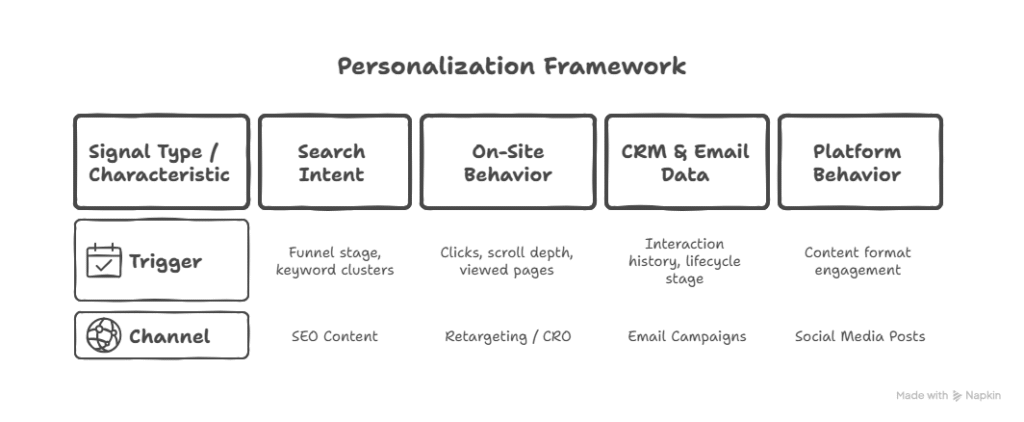
Personalization Framework
| Signal Type / Characteristic | Search Intent | On-Site Behavior | CRM & Email Data | Platform Behavior |
| Trigger | Funnel stage, keyword clusters | Clicks, scroll depth, viewed pages | Interaction history, lifecycle stage | Content format engagement |
| Channel | SEO Content | Retargeting / CRO | Email Campaigns | Social Media Posts |
Segment Audiences With Persona-Based Targeting
Segmentation builds the foundation for personalization. Using ICPs (Ideal Customer Profiles) and JTBD (Jobs to Be Done) ensures messaging aligns with the problems buyers are actively trying to solve.
Best Practices:
- Segment by role, industry, and funnel stage to reflect decision power.
- Use JTBD interviews to link messaging to real-world triggers.
- Define B2B ICPs by company size, budget, and tech stack to guide the scope of offers.
- In B2C, focus on lifestyle signals and motivation drivers.
- Align assets with buyer goals, not just demographics.
Analyze Behavioral Data to Inform Personalization
Behavioral signals show intent more clearly than demographics. Tools like GA4, Hotjar, and CRM platforms surface patterns that marketers can act on instantly.
| Behavioral Signal | Personalization Logic |
| High scroll depth | Serve detailed long-form guides |
| Repeat visits to the pricing page | Trigger BOFU nurturing emails |
| CTA clicks without conversion | Launch retargeting ads with stronger proof |
| Video drop-off at 30s | Replace with shorter, high-impact clips |
| Frequent mobile visits | Deliver mobile-first layouts and CTAs |
Deliver Personalized Content Across Multiple Channels
Each platform requires a unique personalization approach. Using tools like HubSpot Smart Content and Clearbit Reveal, marketers can adapt experiences in real time.
| Channel | Content Type | Variation Example |
| Product recommendations | Based on past purchases or lead score | |
| Website | Headlines, CTAs | Adjusted by firmographics or location |
| Ads | Copy and visuals | Tailored to industry or role segment |
| Chat | Suggested flows, offers | Customized by page history or behavior |
Use Real-Time Personalization to Improve On-Site Experience
On-site personalization adapts instantly to live signals, creating a smoother user journey. Platforms like Mutiny and Dynamic Yield execute these adjustments without developer input.
| User Trigger | Dynamic Content Example |
| Scroll depth > 75% | Insert contextual CTA mid-article |
| Exit intent detected | Show targeted pop-up offer |
| Mobile device detected | Serve mobile-optimized CTA |
| Repeat visit | Display updated product banner |
Automate Personalization With Intent-Driven Triggers
Automation enables personalization at scale. By mapping intent signals to lifecycle stages, advanced platforms like Marketo and Clearbit deliver relevant content without manual intervention.
Funnel-Based Automation Triggers:
- Lead capture: Start welcome sequence with top-funnel assets.
- High lead score: Surface bottom-funnel CTAs, such as demo requests.
- Inactive user: Send re-engagement emails with new offers.
- BOFU activity: Trigger account-based ads after pricing page visits.
- Lifecycle stage change: Update nurture flows to match the current context.
How to Measure and Prove the ROI of Content Marketing
Proving ROI means connecting content to real business outcomes, not surface metrics like clicks or impressions. Effective measurement frameworks show how each asset contributes to pipeline growth, accelerates deal velocity, and drives revenue influence across the funnel.
Track Performance Using Multi-Touch Attribution Models
Attribution models reveal how different touchpoints shape conversions. While single-touch models capture only one stage of the journey, multi-touch distributes credit across all interactions, showing the full impact of content.
Attribution Model Comparison
| Model | Credit Distribution | Best For |
| First-Touch | 100% to first interaction | Awareness content |
| Last-Touch | 100% to final interaction | BOFU decision assets |
| Linear | Equal credit to all touchpoints | Balanced journeys |
| Time Decay | More credit to recent touches | Long sales cycles |
| Data-Driven | Algorithm-based credit | Enterprise accuracy |
Pro Tip: Integrate attribution into CRMs (e.g., HubSpot, Salesforce) to directly link content activity to revenue influence.
Monitor KPIs That Align With Pipeline and Revenue Goals
KPIs should measure how content performs, not just whether it was published. Tracking the right indicators reveals whether assets accelerate buying decisions and contribute to revenue.
Business-Linked ROI Metrics
- Influenced Pipeline: Revenue tied to content-assisted deals.
- Deal Velocity: Average time from first touch to closed-won, showing if content accelerates sales cycles.
- MQL → SQL Conversion Rate: Indicates whether content delivers sales-ready leads.
- Content-Assisted Revenue: Dollar value of deals with content in the buyer journey.
- Touchpoints per Deal: Indicates the extent to which content influences decision-making.
Connect Content Assets to Sales-Influenced Conversions
Proving ROI requires mapping content touchpoints to conversion events. A typical B2B path might flow blog → case study → demo request. By linking assets in this way, teams identify which formats consistently move buyers closer to purchase and where gaps exist.
Use Analytics Tools to Measure Engagement and Impact
Analytics tools surface both behavioral insights and revenue attribution. Combining multiple platforms ensures visibility across the funnel.
Measurement Stack Examples
| Tool | Primary Use |
| GA4 | Tracks sessions, conversions, engagement rates |
| Looker Studio | Builds cross-channel dashboards for visibility |
| Hotjar | Reveals on-page behavior (scroll depth, clicks) |
| Dreamdata | Connects multi-touch content data to B2B revenue |
Report ROI in Business Terms to Stakeholders and Leadership
Executives don’t want vanity metrics; they need proof of efficiency and growth. Reports should frame performance in business terms, tying marketing actions directly to revenue outcomes.
Best Practices for ROI Reporting
- Use visuals (pipeline influence, revenue charts, velocity gains).
- Show before-and-after comparisons or cohort results.
- Translate metrics into business impact (e.g., $X pipeline, Y% faster deals).
- Structure reports around goals, actions, and measurable outcomes.
- Maintain consistent formats for quarterly leadership reviews.
Clear ROI storytelling positions content marketing as a revenue driver, not just a cost center.
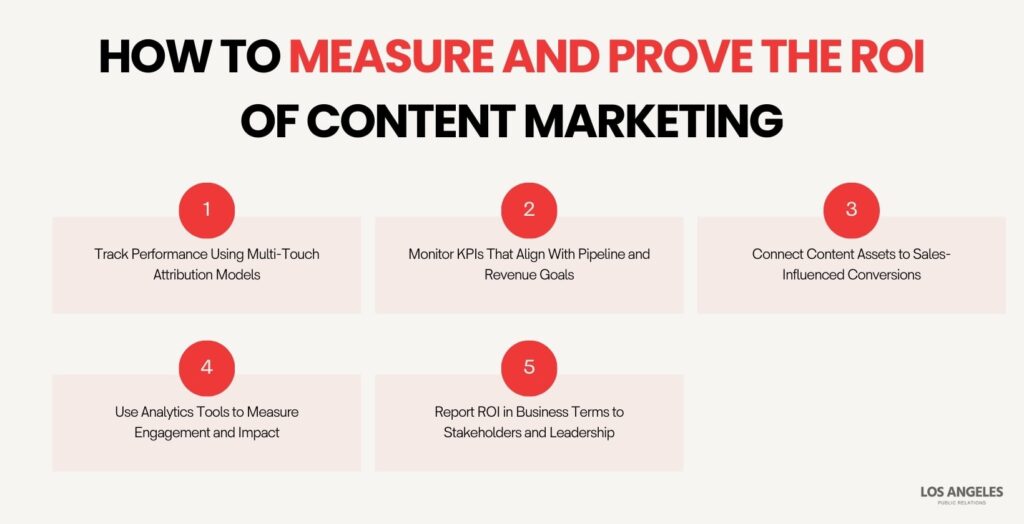
High-Impact Content Formats That Dominate in 2025
In 2025, winning content strategies rely on format diversity. Matching assets to funnel stage, platform, and user behavior ensures brands capture attention, build authority, and drive measurable conversions. Each format plays a distinct role in moving buyers forward.
Blog Articles and Thought Leadership Posts
Blog content remains foundational for SEO in 2025, but only when structured with search intent, internal linking, and E-E-A-T signals. Tactical blog posts capture keyword-driven traffic, while thought leadership positions founders or subject matter experts as trusted voices.
Content Format Comparison:
| Format Type | Purpose | Example Use Case |
| SEO Blog Article | Rank for intent-based queries | “How to Optimize Page Speed for SEO” |
| Thought Leadership Post | Share vision, opinion, or insight | “Why Ethical SEO Will Define the Next Decade” |
Video Content and Product Explainers
In 2025, explainer video marketing remains a top-performing format across the funnel, capturing attention, simplifying complex topics, and accelerating conversions. From demos to testimonials, each video type plays a specific role in driving action.
| Video Type | Funnel Stage | Use Case |
| Explainer Video | TOFU | Introduce a problem and a solution clearly |
| Product Demo | MOFU | Show functionality and value in action |
| Testimonial | BOFU | Build trust and remove objections |
| Walkthrough | MOFU/BOFU | Provide onboarding or in-depth feature guides |
| Video Ad | TOFU | Drive awareness on paid channels |
High-quality video consistently improves engagement, retention, and conversion rates when matched to the right stage of the funnel.
Infographics and Visual Data Assets
Visual formats compress complex ideas into digestible, shareable assets. High-performing infographics not only clarify data but also earn backlinks and improve engagement metrics.
Traits of Effective Infographics:
- Break complex data into clear visuals.
- Follow brand-consistent design and hierarchy.
- Include keyword-rich captions and alt text.
- Encourage shares and embed opportunities.
- Support surrounding long-form assets.
| Use Case Example: A SaaS company visualizes its “Marketing Automation Funnel” in an infographic, earning backlinks and extending time-on-page, both of which are critical SEO signals. |
Podcasts and Audio-Based Education
Podcasts provide long-form, passive engagement that builds authority over time. They work especially well in B2B, where decision cycles are longer and consistent thought leadership builds trust.
| Format | Benefit | Funnel Fit |
| Solo Episodes | Share expert POV, brand vision | TOFU/MOFU |
| Guest Interviews | Add industry validation, reach | TOFU/MOFU |
| Panel Discussions | Encourage debate, topical depth | MOFU |
| Narrative Series | Story-driven education | TPFU/MOFU |
When produced with consistency and clear positioning, podcasts deepen trust, extend brand presence, and support multi-touch engagement throughout the buyer journey.
Case Studies and Data-Backed Proof Points
Case studies reduce hesitation by showing real-world results. They validate ROI with a clear narrative:
Structure: Challenge → Solution → Results
- Challenge: What problem was faced?
- Solution: What service or strategy was applied?
- Results: What measurable outcomes were achieved (e.g., 48% more MQLs)?
At LAPR, we use gated and on-page case studies across email, retargeting, and sales enablement, turning proof into pipeline.
Social Media Micro-Content and Reels
Short-form, platform-native content dominates social in 2025. Micro-content builds brand familiarity, fuels engagement, and powers retargeting flows.
| Platform | Format Examples | Purpose |
| Instagram/TikTok | Reels, behind-the-scenes clips, quick tips | Capture attention and drive discovery |
| Carousels, quote cards, short videos | Position expertise in B2B conversations | |
| X (Twitter) | Threads, polls, stat graphics | Spark topical engagement and sharing |
| YouTube Shorts | Product teasers, educational bites, promo clips | Deliver snackable video for fast learning |
Micro-content builds familiarity at the top of the funnel and supports ongoing engagement by keeping audiences connected across channels.
Why Brands Partner With LAPR for SEO-Driven Content Marketing
Choosing a content partner isn’t just about outsourcing production. It’s about aligning with a team that understands how SEO transforms content into measurable growth. LAPR builds systems where every asset serves both visibility and revenue goals, ensuring brands scale without losing quality or precision.
Delivering SEO-Integrated Content at Scale
Our approach integrates SEO into every step of content creation. From discovery to publishing, assets are mapped to keyword clusters, search intent, and funnel stage—helping businesses in SaaS, B2B, and other verticals capture qualified demand.
How the process works:
- SEO Discovery: Map topics and intent using SERP and competitor data.
- Content Creation: Combine editorial depth with structured SEO frameworks.
- Publishing & Tracking: Monitor performance through GA4, GSC, and CRM integration.
This alignment ensures every piece not only ranks but also drives pipeline results over time.
Using SERP Data to Shape High-Impact Editorial Strategy
Editorial planning starts with real-time SERP intelligence. By analyzing ranking patterns, competitor gaps, and NLP-driven entity data, we create content that precisely matches search intent.
Key techniques include:
- SERP Scraping: Identify winning content types, UX signals, and SERP features.
- Keyword Clustering: Group related queries to cover topics comprehensively.
- Entity Analysis: Strengthen topical authority and reinforce E-E-A-T.
This data-led approach keeps strategies agile, ensuring content adapts as search behaviors shift.
Scaling Results With Cross-Functional Collaboration and Workflow Visibility
Scalable content systems require more than SEO—they need collaboration across teams. LAPR connects strategy, SEO, and execution through structured workflows that eliminate silos and increase speed without sacrificing quality.
Core systems we implement:
- Centralized editorial calendars for shared visibility.
- Defined roles and SLAs to streamline execution.
- Integrated workflows that align SEO, content, and client priorities.
By combining process visibility with strategic execution, we help brands scale content output while maintaining consistency and measurable results.
FAQs About Content Marketing for Modern Brands
What Is the Difference Between Content Strategy and Content Marketing?
The primary difference between content strategy and content marketing lies in their scope. Content strategy is the planning framework, defining goals, personas, and topics, while content marketing encompasses execution, covering creation, distribution, and optimization.
How Often Should Businesses Publish New Content?
To publish new content consistently, businesses should aim for one to four times per week. The frequency depends on resources, audience demand, and calendar planning, but consistent publishing helps build authority and maintain SEO momentum.
What Is the Ideal Budget for a Scalable Content Marketing Program?
The ideal budget for a scalable content marketing program is usually 25–30% of a B2B marketing budget. What’s ideal varies by scale, as the budget must cover strategy, content creation, and promotion.
Can Content Marketing Replace a Sales Team for Lead Generation?
No, content marketing cannot fully replace a sales team. Content marketing reduces sales cycles by generating qualified leads, nurturing buyer intent, and educating prospects pre-conversion, but sales teams remain critical for closing deals.
Do AI Tools Affect Content Quality or SEO Rankings?
Yes, AI tools affect content quality and SEO rankings. AI improves efficiency when paired with editorial oversight, but its misuse can result in low-quality, unoriginal, or non-expert content that harms rankings.
How Often Should SEO Content Be Updated to Maintain Rankings?
To maintain rankings, SEO content should be updated every 3-6 months. How often varies, depending on SERP changes, shifts in search intent, and performance data.
How Long Does It Take to See Results From Content Marketing?
It takes 3-6 months to see measurable results from content marketing. Results compound after 6-12 months, as the impact of SEO and pipeline acceleration grows with consistent execution.
Should Small Businesses Prioritize Content Over Paid Ads?
It depends. Content marketing offers long-term ROI and organic growth, while paid ads provide immediate visibility. Small businesses benefit by balancing content for compounding impact with paid ads for quick wins.
Final Checklist to Launch a Winning Content Strategy
A strategy only succeeds when it’s ready for flawless execution. This involves aligning teams on KPIs, centralizing content systems, and establishing workflows that keep every asset tied to revenue goals. To simplify the process, we’ve created a launch checklist that you can follow step by step.
| Final Launch Checklist |
Execution separates plans from performance. Book a strategy session with LAPR to activate your strategy with SEO-driven systems that scale.



